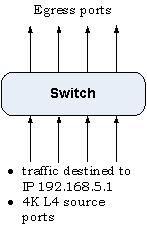Consider the following simple scenario:

- Four hosts are connected on four ports of a switch.
- Ingress traffic from all these four hosts is destined to a single IP destination address.
- The traffic has 4k layer-4 (e.g., UDP or TCP) source ports.
To avoid congestion at the egress, the ingress traffic needs to be distributed and load balanced across a set of egress ports. Table 1 illustrates this scenario across four ports.
| Environment | No of tables | Configuration | Total number of flows required |
|---|---|---|---|
| |||
| OF-DPA + OpenFlow 1.3 |
|
As is evident from the above table, it takes six flow entries with OF-DPA-OF1.3 compared to 4K entries in an OpenFlow 1.0 scenario.
As a step further, consider a scenario where the ECMP hashing leads to an uneven load distribution. This would result in few of the ECMP next hop egress ports getting congested while the rest are underutilized. The ACL Policy Flow table comes to the rescue which can be used to engineer and redirect the identified ingress traffic to underutilized egress ports. A flow entry for each of these elephant flows would need to be installed in the ACL Policy Flow table.
